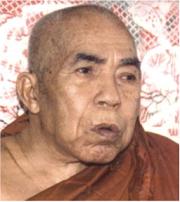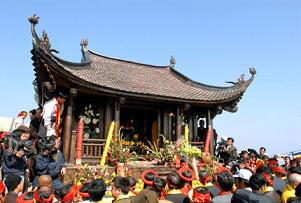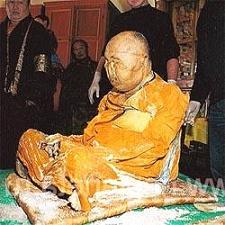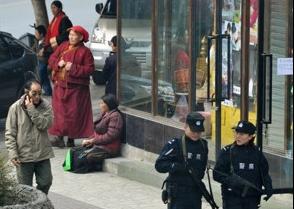Tibetan plight grabs attention of US Senators
Tibetan plight grabs attention of US Senators |
- Tibetan plight grabs attention of US Senators
- Pema Chödrön Foundation announces 2012 Book Initiative
- Buddhist leader Bana Bhante passes away
- Yen Tu Buddhist Spring Festival Begins In Vietnam
- An Opportunity: Zen Ministerial Training In a Buddhist Monastic Setting
- Yamantaka//Sonic Titan
- Maverick Buddhist nun dedicated to helping the needy and homeless
- Russia’s most revered Buddhist monk
- Buddhist revival attracts Russian Buryats to India
- China raises security in Buddhist monasteries, on roadways to prevent spread of Tibet protests
- Browse the March 2012 Shambhala Sun magazine
| Tibetan plight grabs attention of US Senators Posted: 03 Feb 2012 09:00 AM PST
The six U.S. Senators have also called for the release of all those "arbitrarily detained" and to put an end to the intimidation tactics being used against peaceful Tibetan protesters; the resolution also calls for the "unrestricted access of journalists, foreign diplomats and international organisations to Tibet." The resolution was introduced by Senator Dianne Feinstein with support from Senators Barbara Boxer, Dick Durbin, Mark Udall, Joe Lieberman, Marco Rubio, John McCain, and Jim Webb, among others. According to this article, Feinstein said, "I urge the administration to work with our friends and allies in the international community and call on the Chinese Government to begin a substantive dialogue with the Dalai Lama on national reconciliation, respect for the Tibetan culture, and meaningful autonomy for Tibet." In related news… Berkeley City Council has just passed its own resolution in support of Tibet as China's Vice-President Xi Jinping's made his recent trip to California. Passed unanimously by the Berkeley City Council on Tuesday night, the resolution acknowledges the great sacrifice of those who have lost their lives due to self-immolation in Tibet while calling for Tibetan autonomy and a return of His Holiness the Dalai Lama to Tibet. The resolution was co-sponsored by Tenzin Mingyur Paldon of UC Berkeley and Noah Sochet of the Berkeley Peace and Justice Commission. (Photo by LASZLO ILYES via Flickr using a CC-BY license.) Read More @ Source |
| Pema Chödrön Foundation announces 2012 Book Initiative Posted: 03 Feb 2012 07:00 AM PST
This program is for the benefit of individuals who cannot afford books, and to groups and not-for-profit organizations who serve people in need. Along with Pema's books, the Foundation has a limited number of CD titles available. If you are part of an organization that would like to participate in this initiative, an application can be found here. Read More @ Source |
| Buddhist leader Bana Bhante passes away Posted: 02 Feb 2012 08:00 PM PST The Daily Star, January 31, 2012Dhaka, Bangladesh -- Venerable spiritual leader Sadhana Nanda Mohasthabir, widely known as Bana Bhante of Rajban Bihar in Rangamati, passed away in the city yesterday.
He was flown in to the hospital from Rangamati Circuit House by a chopper on Friday noon as he fell unconscious Thursday night. Hospital sources said Bana Bhante breathed his last around 3:15pm at the intensive care unit. Because of his spiritual power acquired through years of meditation in the deep forests of the hill district, local Buddhists consider him to be a living embodiment of the values of Lord Buddha. He was born on January 8 in 1920 in Moghban union of Sadar upazila in Rangamati. His original name was Ratindra Chakma.
The Buddhist community in Rangamati constructed the Rajban Bihar and requested him to take the helm in 1975. Bana Bhante wrote several books about Buddhism -- Suttrapath and Sudristhi. Hearing of his death, hundreds of devotees thronged the hospital. Among them were Industries Minister Dilip Barua, chief of Chakma Circle Raja Devasish Roy and State Minister for Chittagong Hill Tracts Affairs Dipanker Talukder. His body will be kept at Kalabagan ground from 8:00am to 10:00am today for paying last tributes. BNP Chairperson Khaleda Zia has expressed deep shock at the death of Bana Bhante. In separate massages, Bangladesh Buddhist Federation, Parbatya Chattagram Jana Sanghati Samiti and Jatiya Party also expressed their sorrow at the death of the spiritual leader. Read More @ SourceReligions of Peace? This posting includes an audio/video/photo media file: Download Now |
| Yen Tu Buddhist Spring Festival Begins In Vietnam Posted: 02 Feb 2012 07:00 PM PST Bernama, February 2, 2012QUANG NINH, Vietnam -- The Yen Tu Pagoda Spring Festival has opened in the northern coastal province of Quang Ninh on the tenth day of the first lunar month, in the presence of Vice State President Nguyen Thi Doan, according to Vietnam news agency.
Buddhist dignitaries, monks, nuns, followers and visitors joined in a procession and a ceremony to offer incense to King Tran Nhan Tong, who reigned over the country from 1279 to 1293 and then left the throne to devote his life to Buddhist. According to the provincial Party Committee's Secretary Nguyen Van Long the locality made careful preparations to serve pilgrims to the festival. Yen Tu mountain is located about 50km from Ha Long City. The route of the pilgrimage, which winds from the foot of the mountain to its highest peak, is almost 30km. Dong Pagoda, which sits atop the mountain's highest peak, is more than a kilometre above sea level. The area's beautiful natural landscape and awe-inspiring scenery, along with surrounding ancient pagodas and hermitages, are said to have been the reason that King Tran Nhan Tong passed the throne to his son so that he could devote his life living as a Buddhist monk at Yen Tu mountain. Whilst there, he founded the Truc Lam meditation sect, which has led to Yen Tu being recognised as the country's leading centre for Buddhist. Read More @ Source |
| An Opportunity: Zen Ministerial Training In a Buddhist Monastic Setting Posted: 02 Feb 2012 06:00 PM PST by Tom Shogen Hawkins, The Buddhist Channel, Jan 2, 2012San Francisco, CA (USA) -- Currently, the American and Japanese Zen Buddhist organizations (Soto Zen Buddhist Association and the International Sotoshu) are discussing training standard for Zen priests.
These skillful means are traditionally learned within Japanese and other Asian temple communities, from lifelong close relationship with teachers, and Buddhist family rituals, from attending Buddhist Universities, and from centuries of examples of both lay and ordained Buddhists. While we are currently emphasizing the art of meditation, study of Buddhist texts and learning ritual in larger Zen training centers, some Zen teachers, myself included, believe that it is time to teach the Zen equivalent of "seminary or ministerial training" that is customary in the West and the East.
Let us use the language that connects with our hearts and minds rather than trying to connect with 2500 year old terms from another culture and language. This also means applying some skill in group dynamics, a science that didn't exist at the time of the Buddha, but will help to establish the foundation for a healthy sangha. Some may dismiss these offerings as "just psychology." I happen to believe that the Buddha himself was one of the first recorded psychologists. He was convinced that transforming human suffering meant studying one's own mind with discipline and guidance. He did not attribute ability to the traditional caste system of his time, but instead he developed a science and practice for self-observation and self-transformation that could be taught and practiced by any person who was motivated to do so. He did his teaching within a practical and a spiritual context - using all the resources that human beings may engage. "Everything is dependent on mind," he said; "train the mind and happiness will follow". This sounds suspiciously psychological to me; without depending on circumstances or conditions, we need to apply our focus to transforming the mind. We need to transform the mind from a process based on craving and its consequent suffering to an energetic field that meets our own suffering and transforms it to compassion. When we have thus trained the mind, it is a vast resource for alleviating the suffering of all sentient beings. Additionally, the Buddha left us with the message that we needed to translate his teaching, this practice into our own culture, our own language. This has been the unique strength of Meditation as it has traveled throughout Asia from India, to Southeast Asia, to China, Korea, Japan and the West. Meditation has also entered each culture, been assimilated, transformed the culture and transformed itself. In order to train effective Zen leaders we need to make this translation within our traditional practices, rather than just cloning or imitating the image and practice of our Japanese ancestors. The Shogaku Priests Ongoing Training (SPOT) has been developing such trainings—trainings that encourage self-reflection in the midst of relationship and group, which are discussed with teachers and peers. There are also explicit training in giving a Dharma talk from your own experience of practice. Rather than just practice silently, interactions and relationships are encouraged and viewed with compassion and wisdom to build trust and deepen insight. Previously this training required a three year commitment; currently the training is being offered in three week residential intensives, within a traditional monastic schedule. For more information on the July 8-29th 2012 intensive training at Empty Nest Zendo in Central California, please contact Tom Shogen Hawkins tomehawk@ix.netcom.com or see www.shogakuzen.org. Read More @ SourceDalai Lama Stages of Meditation This posting includes an audio/video/photo media file: Download Now |
| Posted: 02 Feb 2012 05:00 PM PST New album now available to play or download from their website: http://yamantakasonictitan.bandcamp.com/ Read More @ SourceTibetan Book of The Dead - The Great Liberation This posting includes an audio/video/photo media file: Download Now |
| Maverick Buddhist nun dedicated to helping the needy and homeless Posted: 02 Feb 2012 04:00 PM PST By TAKESHI NISHIDE, The Japan Times, Feb. 2, 2012Kyodo, Japan -- Koshu Hirao, 58, is not your ordinary Buddhist nun. Since leaving the Jishu sect about 20 years ago because of discord over her antinuclear activities, she has kept her head shaved and her religious garb but has stayed fervently independent.
While Hirao has been doing this for years, her activities have increasingly come under the spotlight as many people have become more aware of the importance of social bonds after the March disasters. As part of her activities, she heads Street Workers Co-op Potalaka, a nonprofit organization that supports the homeless. Potalaka is an ancient Dravidian word that means utopia. In early January, Hirao attended a "shijukunichi" (49th day after death) memorial service at Myoshoji Temple in Mito, Ibaraki Prefecture, for a man who died of colon cancer in November at the age of 61.
Just before passing away he expressed hope of returning to Potalaka, and died peacefully the next morning after being assured he would be allowed to return there. "I wanted to do my part by seeing him off in an appropriate manner, as a divine bond made our paths cross," Hirao said. "Potalaka is a home for homeless people and the staff are their family." Eighteen people live at Potalaka's main shelter facility, which was converted from a construction materials warehouse, most of them in their 60s and 70s. Close by is another facility, intended exclusively for women. Some of the people at these facilities suffer from diseases such as advanced dementia and schizophrenia. As Potalaka is willing to accept people who are shunned elsewhere, Hirao receives a constant stream of applications for shelter. Hirao also operates a shelter facility for refugees from abroad. "Nationality doesn't matter when we help people," she said. The refugees affectionately call her "Mom." Shoko Tokumoto, a manager at a care service facility, expressed admiration for Hirao's iron will in carrying out her relief mission as a Buddhist. "She never closes the door to anyone. That is what's awesome about her," she said. If someone at the Potalaka facilities dies, Hirao gives a posthumous name to the deceased in line with Buddhist practice and covers the body with decent clothes before the funeral ceremony. Her activities increased after the Great East Japan Earthquake that devastated Tohoku and sparked the nuclear crisis. Hirao bought a vacant house in Iwaki, Fukushima Prefecture, a region where locals are fearful over radioactive fallout from the wrecked Fukushima No. 1 nuclear plant. "Keeping the lights on at home is the least I can do," she said. She is looking for more ways to engage in activities to support people in the disaster areas. "Everyone is looking for an excuse for doing nothing. But what we should do is take action," Hirao said. "I enjoy doing what others dodge." Hirao, who hails from Okayama Prefecture, became interested in Buddhist at elementary school when she read about the itinerant Buddhist preacher Ippen (1234-1289) in a history book. She was captivated by the missionary activities of Ippen, who founded the Jishu sect. When she became a nun at the age of 26, she took up residence at a Jishu temple in Obama, Fukui Prefecture, where she met Ryogen Takada, a priest who had been imprisoned before the war for distributing antiwar fliers. Under Takada's guidance, she became involved in protests over nuclear power - activities that eventually led to her departure from the Jishu sect. Despite her exit, Hirao still follows the teachings of "jishuseikai," a collection of sermons by Ippen. "I look to this for a warning against myself. When we set ourselves to do welfare work, we tend to indulge in self-satisfaction," she explained. But feeling pity for the needy is not enough, Hirao said. "Like Ippen, we must stay with them, mourn with them and cry with them." Given her lack of affiliation with a Buddhist sect, Hirao may technically no longer be a nun, but she is determined to stick with the shaved head and religious clothes, which she believes encapsulate the tradition of Buddhist. "I cannot do away with this appearance," she said. "No, I must not throw it away." Read More @ Source |
| Russia’s most revered Buddhist monk Posted: 02 Feb 2012 03:00 PM PST by Ajay Kamalakaran, Special for RIR, January 31, 2012Buryatia, Russia -- The soft power of Buddhist from Buryatia spread far and wide across the Russian Empire. Dashi-Dorzho Itigelov, a Buryat monk who is revered by Buddhists in the country, was awarded the order of St Stanislas by Czar Nicholas II in 1917.
Itigelov was believed to have reached the supreme level of practicing Buddhist and it was in 1927 that he asked to be buried, while in a state of deep meditation. His body, which was exhumed in 2002, was almost intact. Itigelov was buried sitting in lotus posture in a pine box and kept in lama graveyard in Khukhe-Zurkhen in Buryatia. The monk wanted his body to be exhumed by other monks within several years. When the body was exhumed, scientists and pathologists said it was "in the condition of someone who had died 36 hours ago." The body was preserved without any signs of decay with the muscles, inner tissue, skin and soft joints intact. The body was transferred to Ivolginsky datsan, which is now the most important Buddhist pilgrimage site in Russia. Read More @ SourcePema Chodron: Smile at Fear - A Reservoir of Trust This posting includes an audio/video/photo media file: Download Now |
| Buddhist revival attracts Russian Buryats to India Posted: 02 Feb 2012 02:00 PM PST by Ajay Kamalakaran, Special for RIR, January 31, 2012Buryatia, Russia -- India is now looked upon as an inspiration for Buryats looking to return to being practising Buddhists. Buryat students of Buddhism study at Tibetan monastic universities and bring their knowledge back home.
In the ocean of robed monks that descend on important Buddhist sites in India, there are increasing numbers of Russian-speakers, who can easily blend in with East Asian members of the monastic order. These Russians are Buryats, an ethnic group closely related to the Mongols and inhabiting the internal Republic of Buryatia, a Trans-Siberian area that is about one and half times the size of Great Britain. Mahayana Buddhism came to Buryatia from India via Tibet and Mongolia over 400 years ago. The Buryats, who were traditionally Shamanists, embraced the principles of the Buddha and built several towering monasteries on the vast steppes of the Siberian wilderness. While Buddhism flourished in Buryatia for over 200 years, the initiators of the Bolshevik Revolution came down hard on any kind of religious activity. It wasn't until the collapse of the USSR that Buddhism witnessed a revival in areas such as Kalmykia, Tuva and Buryatia.
Among the 1300 Russian Buddhists who came to India for a pilgrimage around the time of the "Kaalchakra," Tamara Sodnomova, a 61-year old doctor from the city of Ulan-Ude felt overwhelmed by her experience. "I met with something so profound it will take some time to truly understand the significance of it," Sodnomova said. "Even though Buryats are traditionally Buddhists, a lot was lost during the 70 years of the Communist regime, and not many of us really know what Buddhism actually is... By attending such teachings, we are inspired to study the profound philosophy of the Buddhism, and learn how to apply its principles in our daily lives." The rigorous curriculum in the Tibetan language consists of memorisation of ancient texts and ritualized debate and it can take anything between 12 to 20 years to be awarded the degree. The Buryat monks obtained their doctorate after rigorous studies and research over a period of 16 years! The monks were the first Buryats to obtain the degrees after a gap of over a hundred years since the Soviet authorities frowned upon religion. Darima Daribazaron, an ethnic Buryat who works for a software firm in Bangalore, attended both the "Kaalchakra" prayers and the convocation of the monks. "I'm very glad I could participate in this ceremony," said Daribazaron, who is a practising Buddhist. "I hope there will be more educated monks who will bring their knowledge back home, and the spirit of Nalanda (an ancient Buddhist university) will continue - in the remote steppes of Buryatia, thousands of miles away from the ancient kingdom Magadhi in the hot plains of north India," she said. Buryat students looking to learn more about Buddhism will soon have another option in India. A consortium led by Singapore that includes India, China and Japan, is spending close to US$ 1 billion to revive the ancient Nalanda University. Nalanda, which was a centre of learning from the 5th century BC, will now host the post-graduate university for research in Buddhism. The revival of this great institution is likely to increase the religious and cultural exchanges and harness the relationship between Buryatia and India. Read More @ Source |
| China raises security in Buddhist monasteries, on roadways to prevent spread of Tibet protests Posted: 02 Feb 2012 01:00 PM PST Associated Press, Feb 2, 2011BEIJING, China -- A senior official in Chinese-ruled Tibet is ordering heightened security in Buddhist monasteries and along key roadways as the government tries to prevent protests that erupted in neighboring Tibetan communities from spreading.
Inspecting security around the Tibetan capital of Lhasa this week, the city's Communist Party secretary, Qi Zhala, warned officials and clerics at monasteries that they would be dismissed if any trouble arose and told police at a highway checkpoint to be alert for acts of sabotage. Officials "must profoundly recognize the important significance of preserving stability in temples and monasteries," the state-run Tibet Daily on Tuesday quoted Qi as saying Monday. "Strive to realize the goal of 'no big incidents, no medium incidents and not even a small incident.'"
Tibetan areas in the neighboring province of Sichuan — on tenterhooks for more than a year as more than a dozen monks, nuns and lay people separately set themselves on fire to protest Chinese rule — saw large demonstrations last week. Tibet support groups outside China said police fired on crowds in three separate areas, killing at least five Tibetans and injuring dozens. The Chinese government said violent "mobs" attacked police and civilians, and officers used force to restore control. It said several officers were injured in the violence. The violence has highlighted anew the government's failure to win over Tibetans and other ethnic minorities through policies to boost economic growth and incomes while increasing police presence and controlling religious practices to deter displays of separatism. State media announced Monday that 8,000 additional police were being recruited in Xinjiang, a traditionally Muslim region north of Tibet that has its own separatist rebellion. Before the latest protests, Chinese security forces were already hunkering down for an annual period of tensions in Tibetan areas: the weeks between the Tibetan new year, which this year falls in late February, and a string of anniversaries in March marking previous anti-Chinese uprisings. A crucial task for the government is to keep the protests in Sichuan from spilling into Tibet proper, especially Lhasa, home to major monasteries that have been at the forefront of previous unrest. In 2008, rioting in Lhasa left at least 22 people dead. Among the stops Qi, the Lhasa official, made on his inspection tour was a key roadway leading from Sichuan into the capital and two major monasteries on the city's outskirts. Qi spoke with members of the monasteries' management committees. The committees are comprised of officials and clerics that Beijing has set up in Tibetan religious institutes to purge them of followers of the Dalai Lama, the Tibetan leader in exile in India. The groups and their controls have contributed to the tensions behind the protests. "They who do not do their jobs responsibly, if any problems happen, will be fired immediately without exception and will be strictly held accountable," Qi was quoted as saying. Read More @ SourceTibetan Sound Healing - Part 2: A This posting includes an audio/video/photo media file: Download Now |
| Browse the March 2012 Shambhala Sun magazine Posted: 02 Feb 2012 10:00 AM PST
Two pieces by the Dalai Lama; Click here to browse full articles, excerpts, and more, now. Thanks, and enjoy! Read More @ Source |
| You are subscribed to email updates from BuddhaRocks ☸ Buddhist To stop receiving these emails, you may unsubscribe now. | Email delivery powered by Google |
| Google Inc., 20 West Kinzie, Chicago IL USA 60610 | |


 The Pema Chödrön Foundation has announced its 2012 Book Initiative, which aims to make the prominent Buddhist teacher's books "available to underserved women and men, and the organizations that serve them, free of charge."
The Pema Chödrön Foundation has announced its 2012 Book Initiative, which aims to make the prominent Buddhist teacher's books "available to underserved women and men, and the organizations that serve them, free of charge." The 93-year-old Buddhist monk was on life support at Square Hospital since Friday with multi-organ failure and respiratory problems due to old age.
The 93-year-old Buddhist monk was on life support at Square Hospital since Friday with multi-organ failure and respiratory problems due to old age. << Yen Tu Pagoda is the center of Buddhist in Vietnam
<< Yen Tu Pagoda is the center of Buddhist in Vietnam We are recognizing, at Zen's 50th birthday in the West, that we have established the foundations of practice, but we have much work to do in helping Zen leaders to translate traditional Eastern rituals into skillful means that include giving Dharma talks, counseling sangha members, creating new rituals, working with group conflict and meeting the interfaith and engaged Buddhist communities.
We are recognizing, at Zen's 50th birthday in the West, that we have established the foundations of practice, but we have much work to do in helping Zen leaders to translate traditional Eastern rituals into skillful means that include giving Dharma talks, counseling sangha members, creating new rituals, working with group conflict and meeting the interfaith and engaged Buddhist communities.  But this unorthodox devotee - who jokingly refers to herself as a "fake nun" who enjoys "costume-playing" - has found her mission in helping the needy, setting up shelters for homeless people and refugees, and providing nursing care for those with severe illnesses.
But this unorthodox devotee - who jokingly refers to herself as a "fake nun" who enjoys "costume-playing" - has found her mission in helping the needy, setting up shelters for homeless people and refugees, and providing nursing care for those with severe illnesses. Itigelov, who attended the tercentenary celebrations of the House of Romanov, opened the Gunzechoyney Datsan in St Petersburg, making it the first Buddhist temple in Europe.
Itigelov, who attended the tercentenary celebrations of the House of Romanov, opened the Gunzechoyney Datsan in St Petersburg, making it the first Buddhist temple in Europe. << Tamara Sodnomova in Bodh Gaya
<< Tamara Sodnomova in Bodh Gaya << (Kyodo News / Associated Press ) - Armed Chinese police officers patrol a Tibetan area of Chengdu in China's Sichuan province, neighboring Tibet, Tuesday, Jan. 31, 2012. Tibetan areas in Sichuan, on tenterhooks for more than a year as more than a dozen monks, nuns and lay people separately set themselves on fire to protest Chinese rule, saw large demonstrations last week.
<< (Kyodo News / Associated Press ) - Armed Chinese police officers patrol a Tibetan area of Chengdu in China's Sichuan province, neighboring Tibet, Tuesday, Jan. 31, 2012. Tibetan areas in Sichuan, on tenterhooks for more than a year as more than a dozen monks, nuns and lay people separately set themselves on fire to protest Chinese rule, saw large demonstrations last week.